Re: Cooking a Life:
We remind ourselves that with the right viewpoint and intention, we can realize this Universal Cosmic Truth: every thing and every person in our lives, from our very start to the present moment, have been rightly placed (ie “perfect”) in the making and baking of who we are. As Alan Watts said: “There isn’t a speck of dust that is out of place in the entire Universe.” Every thing is an ingredient in our lives—take something away, even any of the bad or hard parts, and we are not who we are.
We are perfectly who we are at this moment; each ingredient essential to the becoming of who we’ve become. And ingredients from the farm remain among the highest in quality.
It’s alchemy.
And we are all still being cooked.
Back to Dad as our Elder chef de jour.
~~~~~~~~~~~~~~~
It’s all about the physics of flow.
~~~~~~~~~~~~~~~
“We have NOTHING if we don’t have water” said every farmer, ever. On a farm, no matter what you grow (crops or livestock), THIS is your primary mission: you gotta get water, regularly and amply, to your crop.
THE absolute most dreaded word in the English language for all farmers is “drought.” (FYI—the second most dreaded word for my Dad is…can you guess??? Weeds! Which, btw, also need water…but I digress.)
At his zenith in Moxee, we estimate Dad managed about 130ish acres of hops and some apples. Dad also managed a few head of cattle, off and on, in a small pasture of roughly one acre. Every day of the growing season, 7 days a week, the day started by setting irrigation. And this free-flow of water was on Dad’s mind every single moment. In one way or another, everything we did on the farm was to insure water would get to the hop roots. Every single hop root in every single field on his entire farm—all 130 acres of it.
The reason for this post is due to an admiration that Clary, Trevor, and I have ALWAYS had of our Dad. At our recent family BBQ, (and often in times past), this unique skill or talent of his came up again with great pride and fun stories. So, it merits its own post. It has to do with the very last thing the farmer of the past needed to do for the water to be diverted from the main ditch that travelled past the field to the ditched out, furrowed rows adjacent to the growing plants and then down to the roots of every hop plant. Keep something important in mind: I said “farmer of the past:” all this is before the advent of technology and pumps and drip hoses. Nowadays, Dad’s unique skill, something I’m sure other farmers also had, has been lost to time.
But AT the time, it was the only known way: farmers of the past had to take advantage of ancient wisdom surrounding the physics of the flow of water from a source or high point, to where it was needed—all via the innate power of Mother Earth and gravity and ancient hydro-physics. The photo at the top of this post is the give-away clue—an artifact of days gone by.
~~~~~~~~~~~~~~~~
But First, A Brief Primer:
Agriculture in the Yakima valley—a valley known world-wide as a very fertile region due to it’s geographical location on fertile volcanic soil, under an arid climate, with ample sunlight for most of the year, and proximity to a constant flow of fresh water—relies heavily on the science of irrigation to water crops and grow livestock. The main source of that fresh water comes from the Yakima river—a tributary of the Columbia river into which the Yakima flows near the Tri-Cities in southeastern Washington.
The source of the Yakima river is something most Washingtonians know well, or should—at least those of us who have driven over Snoqualmie Pass: Keechelus Lake. This is the expansive lake just east of the Snoqualmie summit that runs adjacent to I-90. (One of the first things Kristin and I always do, when we come upon Keechelus, is comment on its depth—it is very obvious if it has been a good snowpack year OR if the region is experiencing “drought stress.”)
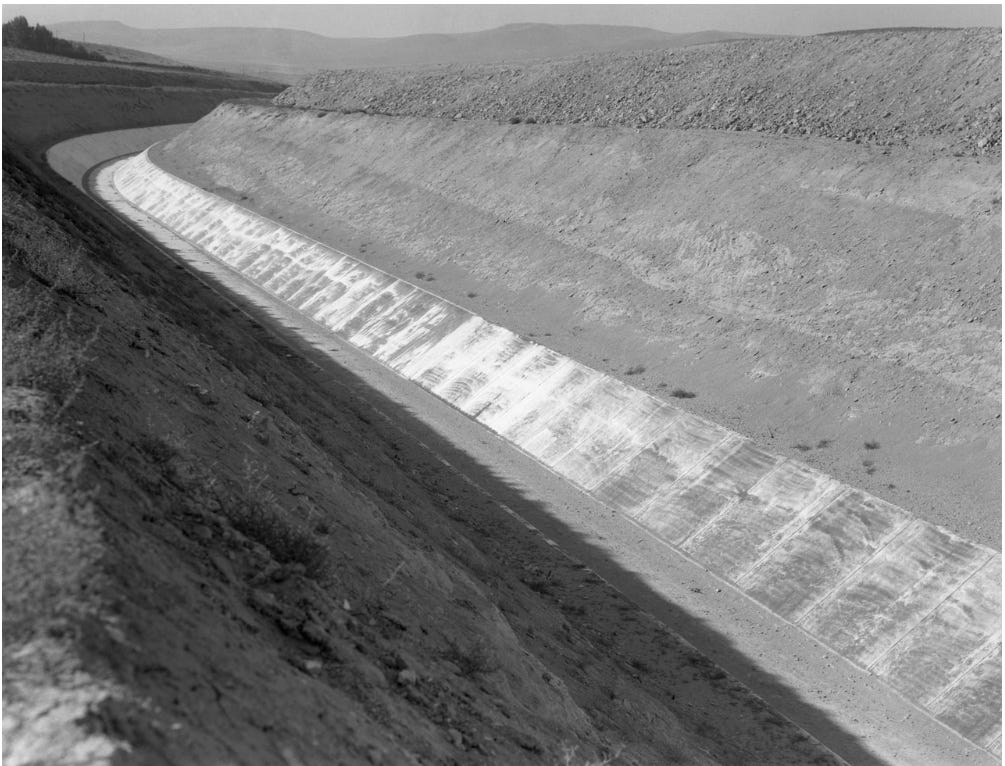
From the Yakima, a series of canals branch off to “feed” various agriculture districts in the valley—like the Roza, which fed our hops in Moxee. Picture this: to get to a hop root, starting ultimately from rain and snowfall dropped in the Cascade mountains and accumulated in Keechelus Lake, a drop of water must travel by river, canal, permanent large ditch, small temporary diversion ditches, to the furrows made by tractor adjacent to every hop plant. But it’s precisely at that last transition point, from small temporary ditch to the furrowed-out row where Dad’s skill still causes his sons joy in recollection.
Let’s see, hmmm…how to get a small stream of water from that ditch there, over that bank there, to this furrow here that’s just three feet away so that my plants get water, while at the same time the water in that ditch there continues on down the way to continue watering all the rest of the furrows in my field, then return back to the main ditch, then the canal, for other farmer to gain access to?
I know! Siphon tubes!!!
(~ not so hypothetical thought from some farmer thousands of years ago)
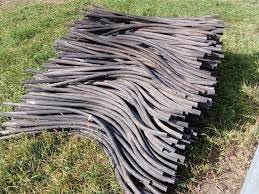
Dad’s Magic, Dad’s Finesse:
In reality, it was just ancient hydro-science involving the water molecules’ ability to adhere to each other (adhesion), to the physics of flow (elevation and gravity), and the fact “nature abhors a vacuum (priming);” but it sure looked like magic to us.

Just as the farmer in the picture is shown doing, Dad would set each tube from the diversion ditch to the furrowed rows using the magic of siphoning—creating a “mini” vacuum in the tube, “priming” it, that the water would then flow to fill thus, if done correctly, creating a constant flow or stream of water. But, it was HOW he did it, with such grace and finesse, that even still, captures his son’s imagination and causes us to enjoy the memory, even at an August 2022 family BBQ in Lake Stevens—what MUST be a full 40+ years removed from the very last tube Dad ever finessed to flow water.
In other words, our Dad had magic powers.
Because we could NEVER do it like he could, tube after tube after tube. Dad could finish an entire 25 acre field before we set our first tube. Trust us, we tried. Like with any craftsman (or magician), you want to be able to do the same thing they do because they make it look so effortless—and even fun. That’s what Dad did with siphon tubes—watching him do this was nothing short of enthralling (and I knew this even at the tender age of 10). And oh how we tried, and tried, and tried to emulate him. I never mastered the art.
The man was like a robot; a mechanical, magic robot: cover one end of a tube with his palm (sometimes TWO tubes simultaneously!), dip once into the small diversion ditch, then “pull” the water up and through the tube and into the lower furrowed ditch where the water would then run to soak each hop plant. This was truly a sight to behold. And we would continue to behold it even as we became soaked and muddy from our own futile effort.
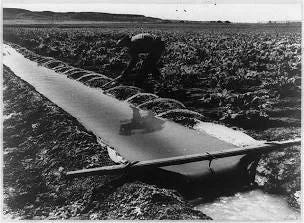
Now, this process of irrigation became obsolete when Trevor and I were fairly young (THANK GOD!!!); being replaced by valves, pumps, PVC pipes, and faucets. The modern farmers of today use very efficient drip line technology (THANK GOD!!!). That old tube technology was woefully inefficient and wasteful. Dad retired before he converted his acreage to the newest technology though. But, as with all nostaligic memories, there is a bit of sadness that we don’t see this skill anymore. The magic of irrigation tubes, the artform, is now lost to the ages. Except in the memories of a certain farmer’s sons.
I firmly believe that if we gave Dad a siphon tube, and set him next to a source of water, the man’s muscle memory would bring back that magic. In fact, give him two. I’m certain he could make it work again!
At least I want to believe this to be true.
My Dad does magic.
~~~~~~~~~~~~~~~~~~
Eldering 101:
Here again is a lesson taught by example. One becomes good at something (ie, a Master), only through endless practice and persistence. Siphon tube irrigation was a necessity by early farmers if, by chance say, they wanted to get water to their crop. This was labor-intensive and backbreaking at times due to the angle one had to be at to create a perfect siphoning action. The movement is repetitive and monotonous—but Dad made it look like a wonderfully choreographed dance—or magic show. And we wanted in on that fun.
And just like an Elder, Dad also very patiently would never tire of trying to teach us how to do it. But this was one of those skills that LOOK easy, yet cannot be mastered simply through watching or being taught verbally. What was needed was an Elder who knew we’d “get it” eventually; so he’d set us up, show us as many times as we needed (which was ALL THE TIME!), then walk silently away to attend to all the rest of the tubes while we gave it our all on our one measly god-forsaken tube—we’d try to mimic Dad’s every move. Dad would always allow us to try, even though he knew, he KNEW we’d make a mess of it and muddy up the entire flow of the main ditch for every other tube down the line. He’d set us on the first couple rows of the field and say “have at it” while he mechanically set the rest of the entire field himself. Eventually, you would get “the feel” of it—mostly for a gloriously fleeting moment. And on the rare occasion when I successfully set a tube after only one pull (which was, did I mention, a RARE occasion?), I would look around for Dad and say: “I did it Dad! And on one pull.” (And then I’d be back to my usual lack-of-success tries at the very next row.) But still, like that single perfect golf shot that brings you back to the course the next day, that one perfect pull of the siphon tube felt AMAZING! And you KNEW you’d get it on the first pull in the next row. Only you didn’t.
But in the next field, or in the next morning, Dad would have us out there doing it all again—making it look like magic; and instilling in us…hope. Because, that’s what farmers, and Elders, and Dads and sons, together, do.
Siphon tubing was an awesome ingredient in our lives. But the most delicious, organic, and wholesome ingredient, was watching Dad showcase “THIS IS HOW YA DO IT, BOYS!”
“I’ll get it THIS time Dad! Dad, watch me. Are you watching Dad!”
Dang it! I still can’t get it on the first try either! (The tube technology is obviously still being used in places likely where the new technology isn’t yet worth the cost or effort—but NO LONGER in Moxee Washington!)
NOTE: my Dad’s even better at it than THAT guy—and even “way down there” Charlie too I’ll bet!
T plus 47 days…and counting.





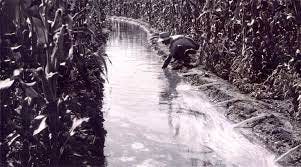
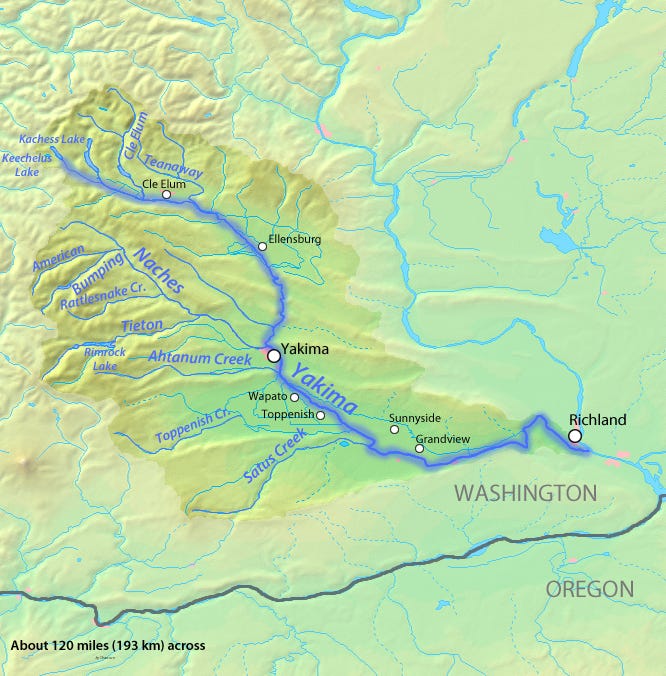


You inherited your Dad’s great teaching skills right there in the ditch.